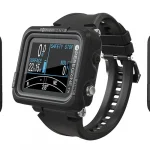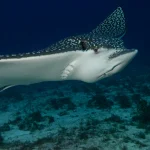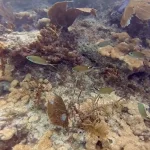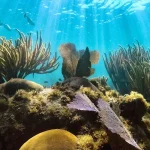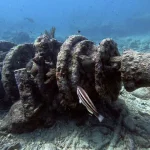Table of Contents
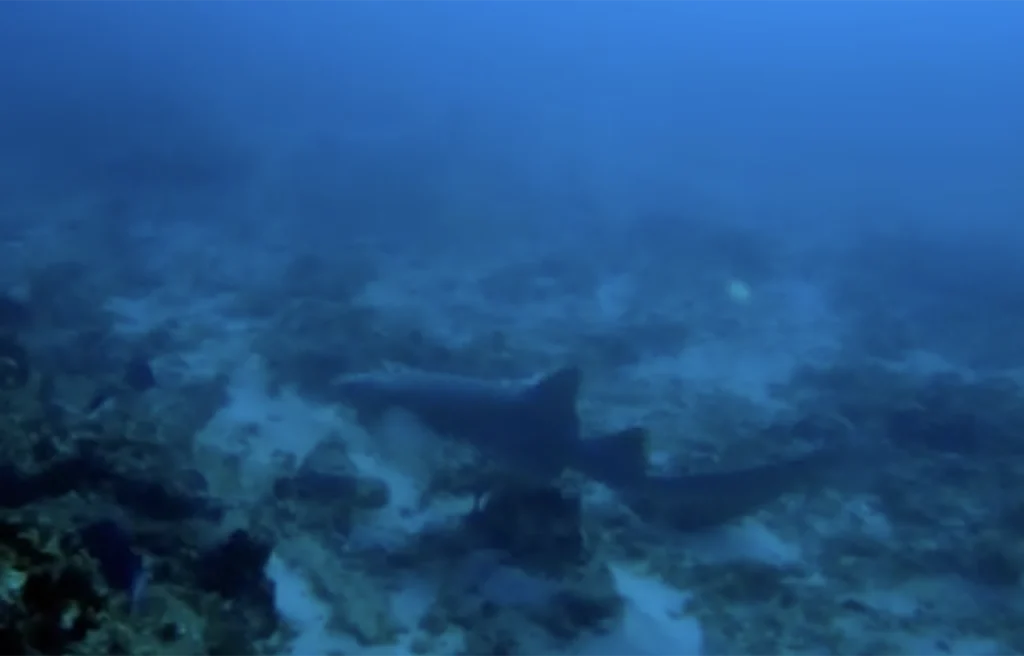
Whether you are an experienced diver or a beginner looking to explore the wonders of the ocean, this dive site promises unforgettable encounters with some of the ocean’s most magnificent creatures.
Article at a Glance
- Location: Situated off Juno Beach, this dive site is part of Florida’s vibrant coral reef ecosystem.
- Depth Range: Dives typically range from 70 to 90 feet (21–27 meters), ideal for intermediate to advanced divers.
- Marine Life: Famous for Caribbean reef sharks, with frequent sightings of turtles, goliath groupers, rays, and colorful reef fish.
- Unique Feature: The Amphitheater, a horseshoe-shaped reef structure, offers a natural and thrilling shark observation experience.
- Visibility: Excellent visibility, often exceeding 50–100 feet (15–30 meters), perfect for photography and marine life observation.
- Best Time to Dive: Year-round diving is possible, but late spring and early fall offer optimal conditions with calm seas and abundant marine life.
- Conservation Focus: Bait-free shark encounters and mooring buoys protect the reef and promote sustainable diving practices.
Shark Canyon West Palm Beach
Shark Canyon, located off the coast of West Palm Beach, Florida, is a renowned dive site famous for its vibrant marine life, particularly its resident shark populations.
Dive Site Overview
- Location: Shark Canyon is situated on the Juno Ledge Reef, approximately 70-85 feet deep.
- Depth Range: The site typically ranges from 70 to 90 feet, making it suitable for open water divers and above.
- Visibility: Conditions often allow for visibility exceeding 100 feet, providing excellent opportunities for photography and observation of marine life.
Diving Experience
- Dive Conditions: Typically, divers can expect mild currents and manageable sea conditions. The site is accessible via boat, and many local dive operators offer trips specifically to Shark Canyon.
- Diving Strategy: Divers are encouraged to settle in designated areas known as “amphitheaters” where they can observe sharks swimming naturally without baiting. This method allows for a more authentic diving experience.
What Marine Life Can I Expect To See?
Shark Species
- Caribbean Reef Sharks: These are the most frequently spotted sharks in Shark Canyon, known for their sleek bodies and inquisitive nature.
- Bull Sharks: Recognized for their aggressive behavior, bull sharks can also be found in the area. They are adaptable and often venture into freshwater.
- Great Hammerhead Sharks: These large sharks, which can reach lengths of up to 20 feet, are occasionally seen hunting in the region.
- Lemon Sharks and Sandbar Sharks: Both species are common in Florida waters and can often be observed during dives.
Other Marine Life
- Turtles: Divers may encounter various sea turtle species, including loggerheads and green sea turtles, which frequent these waters for feeding.
- Rays: The area is known for sightings of different types of rays, including spotted eagle rays and southern stingrays.
- Fish Species: A diverse range of fish populates Shark Canyon, including:
- Snapper: Often found near the reef structures.
- Groupers: These large fish are typically seen resting on the seabed.
- Colorful Reef Fish: Various species contribute to the vibrant underwater scenery.
Coral and Other Invertebrates
The underwater landscape is adorned with beautiful coral formations that provide habitat for numerous marine organisms. Divers can observe various coral species along with anemones and sponges that contribute to the ecosystem’s health.
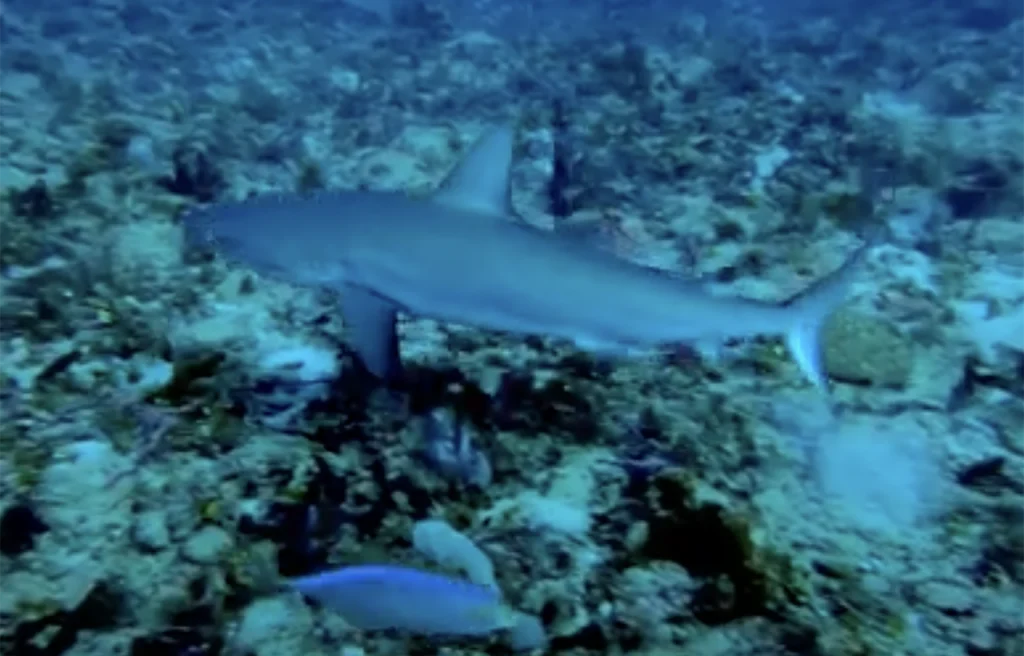
What Do Divers Say About This Site?
Diving Experience
- Incredible Marine Encounters: Many divers are thrilled by the opportunity to see various shark species, including Caribbean reef sharks and lemon sharks. Reviews frequently mention the excitement of being close to these majestic creatures, often describing it as a “once-in-a-lifetime” experience.
- Visibility and Conditions: Divers appreciate the excellent visibility, often exceeding 100 feet, which enhances the overall experience. The water temperature is typically comfortable, making dives enjoyable even for longer durations.
Guided Tours and Safety
- Professional Guides: Divers commend the professionalism and knowledge of dive instructors. Many reviews highlight how guides prioritize safety while ensuring that divers feel comfortable and engaged throughout the experience. For example, Lauren from Swim with Sharks is noted for her attentiveness and commitment to conservation, making divers feel safe while also educating them about the marine environment.
- Friendly Atmosphere: The dive charters are praised for their friendly and welcoming environment. Many divers mention that the crew creates a fun atmosphere, which adds to the enjoyment of the dive.
Unique Features
- Rich Biodiversity: Beyond sharks, divers report seeing a variety of marine life, including turtles, groupers, and schools of spadefish. This diversity makes each dive unique and exciting.
- Memorable Experiences: Participants often express their desire to return, indicating that the experiences at Shark Canyon leave lasting impressions. Many divers describe their trips as “amazing” and “unforgettable,” emphasizing the emotional connection they feel during their dives.
Key Information
| Category | Details |
|---|---|
| Location | Off the coast of West Palm Beach, Florida, near Juno Beach |
| Depth Range | 70–90 feet (21–27 meters) |
| Dive Type | Reef dive with opportunities for drift diving |
| Marine Life Highlights | Caribbean reef sharks, bull sharks, hammerhead sharks, goliath groupers, turtles, rays |
| Visibility | Typically 50–100 feet (15–30 meters), with excellent visibility on calm days |
| Water Temperature | – Winter: 68–74°F (20–23°C) |
| – Summer: 78–84°F (26–29°C) | |
| Skill Level | Suitable for open water-certified divers and above; ideal for intermediate to advanced divers |
| Unique Features | The “Amphitheater” – a horseshoe-shaped reef structure where sharks can be observed naturally |
| Access | Boat dive; local dive charters operate trips to the site |
| Best Time to Dive | Year-round diving; late spring and early fall offer optimal conditions |
| Currents | Mild to moderate; drift diving is common |
| Recommended Gear | – Wetsuit: 3mm in summer, 5mm in winter |
| – Underwater camera for photography | |
| Conservation Practices | Bait-free shark encounters, mooring buoys to protect reefs |
Highlights of Diving This Site?
. Shark Encounters
- Shark Canyon is renowned for its Caribbean reef sharks, which often swim naturally around divers. Other species such as hammerhead sharks and bull sharks are occasionally spotted, making it a thrilling experience for shark enthusiasts.
The Amphitheater
- A unique feature of the site is the “Amphitheater,” a horseshoe-shaped cutout in the reef ledge. Divers can sit in the sand here and observe sharks swimming around naturally without baiting, offering an authentic and eco-friendly shark diving experience.
Diverse Marine Life
- In addition to sharks, divers often see green sea turtles, hawksbill turtles, spotted eagle rays, and a variety of reef fish along the ledges and coral formations.
Natural Reef Structures
- The reef features a 4-foot ledge extending northward from the Amphitheaters, teeming with marine life and providing excellent opportunities for exploration and photography.
Excellent Visibility
- Visibility at Shark Canyon is typically high, enhancing the overall experience and making it easier to observe marine life in detail.
My Favorite Dive Computers
I have compared the 3 top diving computers for each category to help making the right choice easier:
Iconic Spots At This Site
The Amphitheater
- This is the most famous feature of Shark Canyon, characterized by a horseshoe-shaped cutout in the reef ledge. Divers can sit in the sand and observe Caribbean reef sharks swimming around without baiting, providing a natural and thrilling encounter with these magnificent creatures. It’s recommended to stay still for about 10 minutes to allow sharks to approach closely.
Deep Ledge
- Located near the Amphitheater, this area drops to depths of 70-85 feet (21-26 meters). The deep ledge is home to various marine life, including goliath groupers and turtles, making it an excellent spot for exploration and photography.
Second Amphitheater
- A lesser-known but equally engaging area, this second amphitheater offers another opportunity for divers to observe sharks and other marine life in a similar setting as the first. It provides a unique experience and is often less crowded.
Coral Formations
- The surrounding reef structures are rich in biodiversity, featuring various coral species and supporting an array of marine life, including schools of fish, sea turtles, and rays. These formations contribute to the vibrant underwater scenery that divers enjoy.
Marine Life Encounters
- Beyond sharks, divers can frequently see loggerhead turtles resting under ledges, spotted eagle rays gliding by, and various fish species that inhabit the reef. This diversity makes every dive unique and exciting (4)(5).
Environmental Conservation Efforts at Shark Canyon
Natural and Artificial Reef Protection
- Natural Reef Conservation: Shark Canyon is part of Florida’s Coral Reef, the largest coral reef system in the continental U.S., stretching 360 miles from the St. Lucie Inlet to the Dry Tortugas. These reefs provide critical habitat for marine life, including sharks, turtles, and reef fish (1)(2).
- Artificial Reef Program: Palm Beach County has implemented an artificial reef program to reduce pressure on natural reefs. Over 140,000 tons of limestone and other materials have been used to create artificial reefs, which serve as habitats for marine species and help protect natural reef areas from overuse (1).
Shark Conservation
- Bait-Free Shark Encounters: At Shark Canyon, divers can observe sharks without baiting, promoting natural interactions and reducing stress on marine life. This practice aligns with conservation principles by minimizing human impact on shark behavior.
Coral Restoration and Management
- Coral Health Monitoring: Conservation programs monitor the health of coral reefs, fish populations, and water quality to track ecosystem trends and address threats such as pollution and climate change (2).
- Mooring Buoys: To prevent anchor damage to delicate coral reefs, mooring buoys have been installed in popular dive sites like Shark Canyon. These buoys help maintain the integrity of the reef ecosystem (2).
Public Outreach and Education
- Conservation agencies conduct education campaigns to inform visitors about responsible diving practices, such as avoiding contact with coral and respecting marine life, ensuring sustainable use of these ecosystems (2)(3).
Economic and Coastal Protection Benefits
- Natural reefs like those at Shark Canyon not only support marine biodiversity but also protect shorelines by absorbing wave energy during storms. Additionally, these ecosystems contribute significantly to the local economy through recreational diving and tourism, generating $280 million annually in Palm Beach County alone (1)(2).
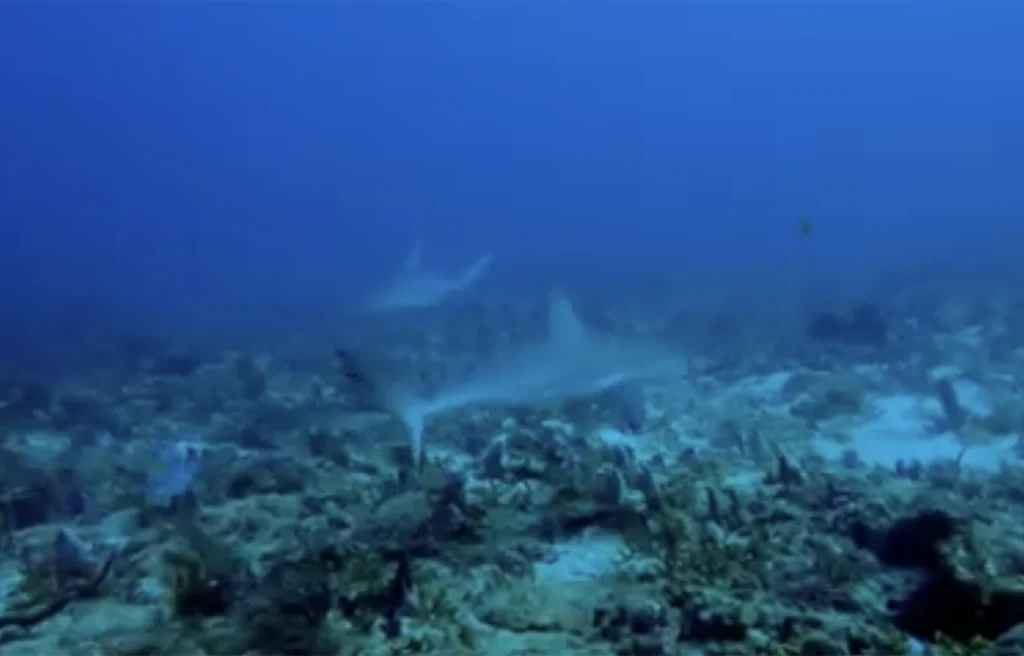
Maximizing Your Diving Experience at Shark Canyon
Choose the Right Dive Operator
- Calypso Dive Charters is highly rated (4.9 stars) and offers guided dives specifically to Shark Canyon. They provide professional guidance, ensuring safety and enhancing the overall experience1. Other operators like Pura Vida Divers also offer excellent services and knowledgeable staff.
Timing Your Dive
- Optimal Conditions: Plan your dive around slack tide for the best conditions. This typically means entering the water about 30 minutes before high tide when currents are minimal, allowing for a more enjoyable experience.
The Amphitheater Experience
- Spend time in the Amphitheater, a unique feature of Shark Canyon where you can sit on the sand and observe sharks as they swim naturally around you. It’s recommended to remain still for about 10 minutes to allow sharks to approach closely without baiting, providing a more authentic encounter.
Gear Up Appropriately
- Ensure you have the right gear for deeper dives (depths range from 70-85 feet). A wetsuit appropriate for mid to upper 70s°F water temperatures will keep you comfortable during your dive.
Photography Opportunities
- With visibility often exceeding 100 feet, bring an underwater camera to capture the vibrant marine life, including sharks, turtles, and colorful reef fish. The clear waters provide excellent conditions for photography.
Respect Marine Life
- Practice responsible diving by avoiding contact with coral and maintaining a safe distance from marine animals. This not only protects the ecosystem but also enhances your experience by allowing natural interactions with wildlife.
Explore Beyond Shark Canyon
- Consider combining your dive at Shark Canyon with visits to nearby sites like the Princess Anne wreck, which can provide additional encounters with marine life such as goliath groupers and loggerhead turtles.
Engage with Guides
- Take advantage of the knowledge offered by your dive guides. They can provide insights into marine life behavior, conservation efforts, and tips for maximizing your underwater experience.
Capturing Memories at Shark Canyon: Photography Tips
Equipment and Settings
- Wide-Angle Lens: Use a wide-angle lens (10-17mm fisheye or 12-24mm) to capture the large sharks and reef structures in their entirety.
- Camera Settings:
- Mode: Manual mode is ideal for controlling exposure.
- Aperture: Set between f/8 and f/16 for sharpness and depth of field, especially when shooting into sunlight or capturing silhouettes.
- Shutter Speed: Use 1/125 to 1/250 to freeze motion, or faster if syncing with strobes.
- ISO: Keep ISO low (200-400) for bright conditions but adjust higher in deeper or darker waters.
- Lighting: Use strobes for vibrant colors, but turn them off if there’s backscatter or when shooting silhouettes (6).
Composition Tips
- Get Low: Position yourself below the sharks to shoot upwards, creating dramatic silhouettes against the sunlight.
- Focus on the Eyes: Sharks’ eyes are expressive and make compelling focal points for your shots.
- Include Context: Incorporate divers, reef structures, or sunbursts to add scale and perspective to your images.
- Avoid Distractions: Keep other divers’ bubbles or equipment out of your frame by scouting your surroundings before shooting.
Techniques for Shark Photography
- Natural Behavior: Capture sharks in their natural movements by staying calm and still. Avoid baiting for ethical photography.
- Safety Stops: Utilize safety stops to capture sharks in the open water column or experiment with over-under shots at the surface using a dome port.
- Golden Hour Shots: If possible, dive during sunrise or sunset for stunning light rays and golden hues in your photos (5).
Practical Advice
- Plan Repeat Dives: Familiarize yourself with the site on the first dive and refine your shots on subsequent dives.
- Stay Close to Subjects: Water reduces clarity; staying within 3-5 feet of your subject ensures sharper images with better color saturation.
- Respect Wildlife: Avoid chasing sharks or disturbing their natural behavior for ethical and impactful photography.
Post-Dive Tips
- Shoot in RAW format for flexibility in post-production editing, allowing you to adjust exposure, contrast, and color balance effectively.
Frequently Asked Questions
When is the best time to dive Shark Canyon?
The best time to dive at Shark Canyon in West Palm Beach varies based on several factors, including water temperature, visibility, and marine life activity.
Year-Round Diving
Diving Season: Shark Canyon offers year-round diving opportunities, making it accessible regardless of the season. The underwater environment remains vibrant throughout the year.
Water Temperature
Winter (December to February): Water temperatures typically range from the upper 60s to low 70s °F (approximately 15-22 °C). A 3mm wetsuit is often recommended for comfort.
Summer (June to August): Temperatures can rise to the low 80s °F (around 26-29 °C), providing a comfortable diving experience with lighter wetsuits or even just swim trunks.
Visibility
Seasonal Variations: Visibility can fluctuate significantly:In winter, visibility often reaches up to 100 feet, making it ideal for photography and observing marine life.
In summer, visibility can vary from 40 to over 100 feet, depending on weather conditions and currents.
Marine Life Activity
Shark Sightings: Shark activity is prevalent year-round, but divers often report increased encounters during warmer months when marine life is more active. The natural behavior of sharks can be observed without baiting, enhancing the diving experience.
Weather and Sea Conditions
Calm Seas: Generally, calm seas are preferable for diving, which are more common in late spring and early fall. Checking local weather forecasts before planning your dive can help ensure optimal conditions.
What is the visibility like while diving Shark Canyon?
Visibility at Shark Canyon in West Palm Beach can vary depending on conditions, but it is generally excellent, making it a popular dive site.
Average Visibility: Typically ranges from 26-30 feet (8-9 meters) under normal conditions.
Optimal Visibility Days: On good days, visibility can exceed 100 feet (30+ meters), especially when the Gulf Stream brings clear, warm water close to the reef.
Seasonal Variations: Visibility tends to be better during winter and spring, often reaching up to 70-100 feet (21-30 meters), as reported by divers during specific trips.
How deep are the dives at Shark Canyon?
Dives at Shark Canyon typically range from 70 to 85 feet (approximately 21 to 26 meters) deep. Some sources indicate that the maximum depth can reach up to 90 feet (about 27 meters) in certain areas of the dive site.
This depth range makes it suitable for open water divers and above, providing an exciting environment to observe diverse marine life, including Caribbean reef sharks and other species.
Is Shark Canyon suitable for beginners?
Shark Canyon is generally considered suitable for open water divers and above, but there are several factors to keep in mind regarding its appropriateness for beginners:
Depth and Conditions
Depth: The dive site ranges from 70 to 85 feet (approximately 21 to 26 meters), which is within the limits for open water certified divers. However, the maximum depth can reach up to 90 feet (about 27 meters) in certain areas, which may be challenging for inexperienced divers.
Currents: While Shark Canyon can have mild currents, conditions can vary. Beginners should be cautious and ideally dive with experienced guides who can assess the current conditions.
Marine Life
The presence of Caribbean reef sharks and other marine life can be thrilling for beginners, but it may also be intimidating. Divers should be comfortable with the idea of encountering larger marine animals.
Guided Dives
It is highly recommended that beginners dive with a reputable dive operator that offers guided tours. Experienced guides can provide safety instructions and ensure that divers remain safe while enjoying the underwater experience.
Is Shark Canyon suitable for advanced divers?
Yes, Shark Canyon is highly suitable for advanced divers, offering thrilling experiences and challenges that align with their skill level.
Depth and Conditions
The dive site typically ranges from 70 to 85 feet (21–26 meters), with some areas reaching up to 90 feet (27 meters), making it ideal for advanced divers comfortable with deeper dives.
Currents: While currents are generally mild, they can vary, adding an extra element of excitement for experienced divers who are adept at drift diving.
Marine Life Encounters
Advanced divers will appreciate the opportunity to encounter Caribbean reef sharks, goliath groupers, and other large marine species in their natural habitat. Observing these creatures without baiting enhances the authenticity of the experience.
Unique Features
The site’s Amphitheater provides a dramatic underwater setting where divers can observe sharks swimming naturally. This feature is particularly appealing for those seeking a more immersive experience.
Photography Opportunities
With visibility often exceeding 50–100 feet (15–30 meters), advanced divers can take advantage of excellent conditions for underwater photography, capturing stunning images of marine life and reef structures.
Skill Requirements
While Shark Canyon is accessible to open water-certified divers, advanced certification or significant diving experience is recommended to fully enjoy the depth, conditions, and marine encounters.
Palm Beach Diving Sites
- Blue Heron Bridge
- Breakers Reef
- Flower Gardens
- Juno Ledge
- King Neptune
- Northwest Double Ledges
- South Double Ledges
- Cable Crossing
- Breakers 3rd Window
- Rons Rock
- Ballentine Reef
- Worth Avenue Pier Debris
- Playpen or Playground
- Bath and Tennis
- North and South Turtle Mounds
- Shark Canyon
- Larsens Valley
- Hole in the Wall

